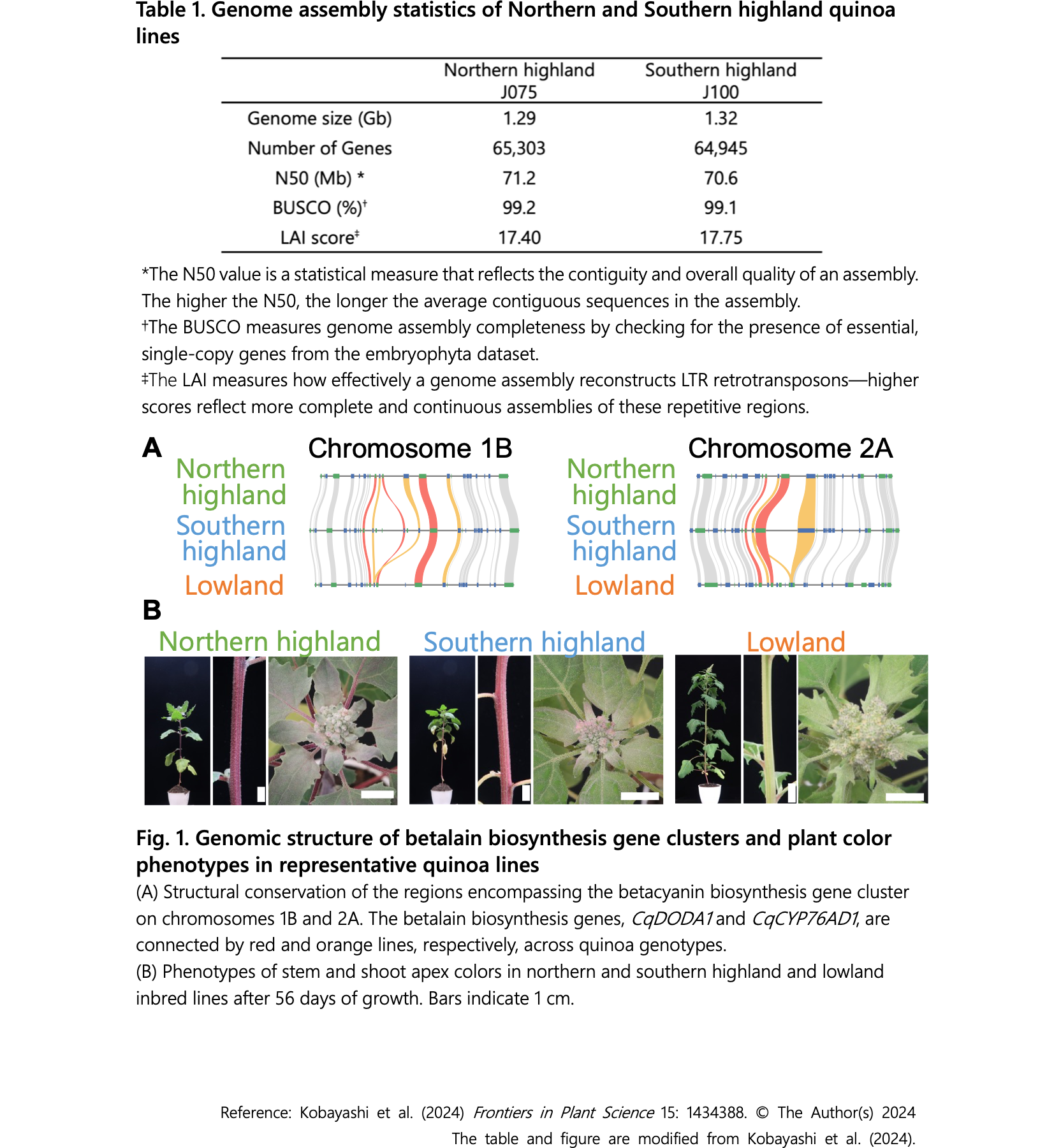Chromosome-level genome assemblies for highland quinoa cultivated in the Andean highlands
Description
Quinoa is emerging as a key seed crop for global food security due to its ability to grow in marginal environments and its excellent nutritional properties. Our comprehensive genomic analyses revealed that the quinoa inbred lines can be categorized into three genetic sub-populations: the northern highland, southern highland, and lowland groups (2020 Research Highlights: Genetic and phenotypic variation of agronomic traits and salt tolerance among quinoa inbred lines). However, unlike lowland quinoa lines, no useful genomic information is available for highland quinoa lines. The high-quality genome assemblies obtained in this study will provide the basis for advancing functional genomics in quinoa to facilitate the development of climate-adapted highland quinoa breeding materials and contribute to a better understanding of the domestication process of quinoa, including its adaptation to harsh environments and its origin.
The whole genome sequences of J075 as a representative line of northern highland quinoa, and J100 as a representative line of southern highland quinoa were decoded using PacBio high-fidelity (HiFi) sequencing. Furthermore, we obtained their chromosome-level genome assemblies by integrating the HiFi sequencing reads and aligning them using the linkage map generated by dpMig-Seq. The assembled genomes of J075 and J100, each comprising 18 pseudochromosomes, exhibited sizes of 1.29 Gb and 1.32 Gb, with contig N50 values of 66.3 Mb and 12.6 Mb and scaffold N50 values of 71.2 Mb and 70.6 Mb, respectively, and were predicted to harbor 65,303 and 64,945 genes. As an example of comparative analysis of genome structure and diversity among quinoa genotypes, we selected genes homologous to the reported betalain biosynthetic gene sequences from each line and assessed genomic structural variation. Regions on chromosomes containing clusters of betalain synthesis genes CqDODA1 and CqCYP76AD1 were less conserved in genome structure compared to adjacent regions in each line, suggesting their association with the phenotypic differences between the dark-red highland and the light-colored lowland quinoa.
Detailed comparative analysis of genomes among representative quinoa genotypes is expected to facilitate the selection of crop design materials for developing quinoa varieties with enhanced stress tolerance, yield stability, and high nutritional value, which are critical for food security. These genomic data are publicly available via the Kazusa DNA Research Institute’s "Plant GARDEN" portal.
Figure, table
- Research project
- Program name
- KAKEN
- Term of research
-
FY2021-2024
- Responsible researcher
-
Kobayashi Yasufumi ( Biological Resources and Post-harvest Division )
ORCID ID0000-0002-8357-6579KAKEN Researcher No.: 00836968Nagatoshi Yukari ( Biological Resources and Post-harvest Division )
Fujii Kenichiro ( Biological Resources and Post-harvest Division )
ORCID ID0000-0001-7621-5962fujita Yasunari ( Program Director (Food) )
ORCID ID0000-0002-5036-8319KAKEN Researcher No.: 00446395Hirakawa Hideki ( Kazusa DNA Research Institute )
ORCID ID0000-0002-7128-7390KAKEN Researcher No.: 80372746Shirasawa Kenta ( Kazusa DNA Research Institute )
ORCID ID0000-0001-7880-6221KAKEN Researcher No.: 60527026Nishimura Kazusa ( Okayama University )
ORCID ID0000-0003-3298-8271KAKEN Researcher No.: 60835453Oros Rolando ( PROINPA Foundation )
Almanza Giovanna Rocio ( Universidad Mayor de San Andres )
ORCID ID0000-0002-5362-252XYasui Yasuo ( Kyoto University )
ORCID ID0000-0003-3804-7886KAKEN Researcher No.: 70293917 - ほか
- Publication, etc.
-
Kobayashi et al. (2024) Front. Plant Sci. 15: 1434388.https://doi.org/10.3389/fpls.2024.1434388
- Japanese PDF
-
2024_B02_ja.pdf867.6 KB
- English PDF
-
2024_B02_en.pdf657.74 KB
* Affiliation at the time of implementation of the study.

